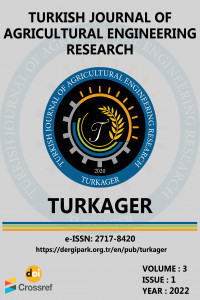Ziyaret Gölet Havzası Akımlarında Tarımsal Uygulamalara Bağlı Olarak Cu++, Fe++, Zn++ ve Cl- içeriklerinin Zamansal Değişiminin Araştırılması
Su kalitesi, Su kirliliği, Bakır, Demir, Çinko, Klor
Investigation of Temporal Change of Cu++, Fe++, Zn++ and Cl- Contents Depending on Agricultural Practices in Ziyaret Pond Basin Flows
Water quality, Water pollution, Copper, Iron, Zinc, Chlorine,
___
- Alvarez-Rogel J, Jımenez-Carceles FJ and Egea Nıcolas C (2006). Phosphorus and nitrogen content in the water of a Coastal Wetland in the Mar Menor Lagoon (Se Spaın): Relationships with effluents from urban and agrıcultural areas. Water, Air, and Soil Pollution 173: 21–38.
- APHA (1998). Standard Methods for the Examination of Water and Wastewater. 20th Edition, American Public Health Association, Washington, DC
- Batbayar G. Pfeiffer M. Kappas M and Karthe D (2019). Development and application of GIS-based assessment of land-use impacts on water quality: A case study of the Kharaa River Basin. Ambio , 10:1154–1168.
- Borics G, Acs E, Boda P, Boros E, Er}os T, Grigorszky I, Kiss KT, Lengyel S, Resko NM, Somogyi B,and Vo L (2016). Water bodies in Hungary—an overview of their management and present state. Hungarian Journal of Hydrology 96: 57–67.
- DMİ (2026). Devlet Meteoroloji İşleri Genel Müdürlüğü yazılı görüşme kayıtları.
- Dutta S, Dwivedi A and Suresh KM (2018). Use of water quality index and multivariate statistical techniques for the assessment of spatial variations in water quality of a small river. Environ. Monit. Assess. 190.
- Hu J, Liu M, Zhou W, Xu C, Yang XJ, Zhang SW and Wang L (2011). Correlations between water quality and land use pattern in Taihu Lake basin. Chin. J. Ecol. 30:1190–1197.
- KHGM (1991). Amasya İli Arazi Varlığı. Köy Hizmetleri Genel Müdürlüğü, Etüd ve Proje Daire Başkanlığı Yayınları, İl Rapor No: 05, s. 16.
- Li, XA (1996). Review of international researches on land use/land cover change. Acta Geogr. 51:553–558.
- Mert R, Bulut S, Yildirim G, Yilmaz M ve Gul A (2010). Damsa Baraj Gölü (Ürgüp) suyunun bazı fizikokimyasal parametrelerinin araştırılması. Gazi Üniversitesi Eğitim Fakültesi Dergisi 30(2): 285-302
- Mutlu E, Kutlu B and Demir T (2016). Assessment of Çinarli Stream (Hafik -Sivas)’s water quality via physicochemical methods. Turkish Journal of Agriculture - Food Science and Technology 4(4): 267-278.
- Oğuz İ, Yürekli K and Öztürk F (2010). Tokat Uğrak Havzası Günlük Akımların Modellenmesi, Gaziosmanpaşa Üniversitesi Ziraat Fakültesi Toprak ve Bitki Besleme Bölümü, Tarım Bilimleri Araştırma Dergisi, 3 (1): 7-11. Oğuz İ, Kaya İ, Koçyiğit R (2029). Investigation of the Temporal Variation of Water Quality in Ziyaret Pond Basin, Journal of Agricultural Sciences, 25 (2019) 215-223.
- SKKY, 2008. Su Kirliliği Kontrolü Yönetmeliği.
- Stoate CN, Boatman R, Borralho CR, Carvalho GDS and Eden P (2001). Ecological impacts of arable intensification in Europe. Journal of Environmental Management 63: 337–365.
- Szewran´ski S, Chrus´cin´ski J, Van Hoof, J and Kazak, JK, ´Swia˛der, M. Tokarczyk-Dorociak, K. and ˙Zmuda, RA (2018). Location intelligence system for the assessment of pluvial flooding risk and the identification of storm water pollutant sources from roads in suburbanized areas. Water, 10, 746.
- Yayın Aralığı: Yılda 2 Sayı
- Başlangıç: 2020
- Yayıncı: Ebubekir ALTUNTAŞ
Assessment of Physicochemical Properties of Soil at Old Nekede Dumpsite Owerri, Imo State, Nigeria
Ahaneku ISIGUZO, Igbojionu OKWUDIRI, Christopher OBİNECHE
Çorum İlinde Çeltik Tarımında Makina Kullanım Projeksiyonun Tahmini
Sultansuyu Tarım İşletmesi Süt Sığırcılığı Faaliyetlerinde Girdi ve Maliyetlerin Belirlenmesi
Veysel Kaya YIĞMATEPE, Mehmet Metin ÖZGÜVEN
Moisture Influence on Some Physical and Gravimetric Properties of Ackee Apple (Blighia sapida) Seeds
Olajıde SADIKU, Davıd OMOGUNSOYE
Karaman İli Süt Sığırcılık İşletmelerinin Mekanizasyon Özellikleri
Abdullah KAYA, Haydar HACISEFEROĞULLARI
Development and Optimization of a Manual Fed Cassava Root Chipper for Household Cassava Processors
Nnaemeka NWAKUBA, Macmanus NDUKWU, Gabriel AFAM
Yield Estimation of Winter Wheat in Pre-harvest Season by Satellite Imagery Based Regression Models
Ediz ÜNAL, Hakan YILDIZ, Ali MERMER, Metin AYDOĞDU
Some Bio-Technical Properties of Flax Seeds, Fennel Seeds and Harmal Seed Capsules
Güngör YILMAZ, Ebubekir ALTUNTAŞ
Development of a Low Cost Two- Row Groundnut Planter
